Nerium Oleander – How to Grow and Care for an Oleander Plant
Nerium Oleander “Oleander” is a beautiful flowering evergreen shrub that grows up to 9ft and brightens up any garden, usually flowering all summer long into October.
Its one of the most versatile evergreen shrubs due to the fact that they can tolerant a wide range of conditions, including drought, heat, salty soil, salt spray, high PH and excessive pruning. Take a trip to Portugal and you’ll see the Oleander plant all along the central reservation of motorways there.
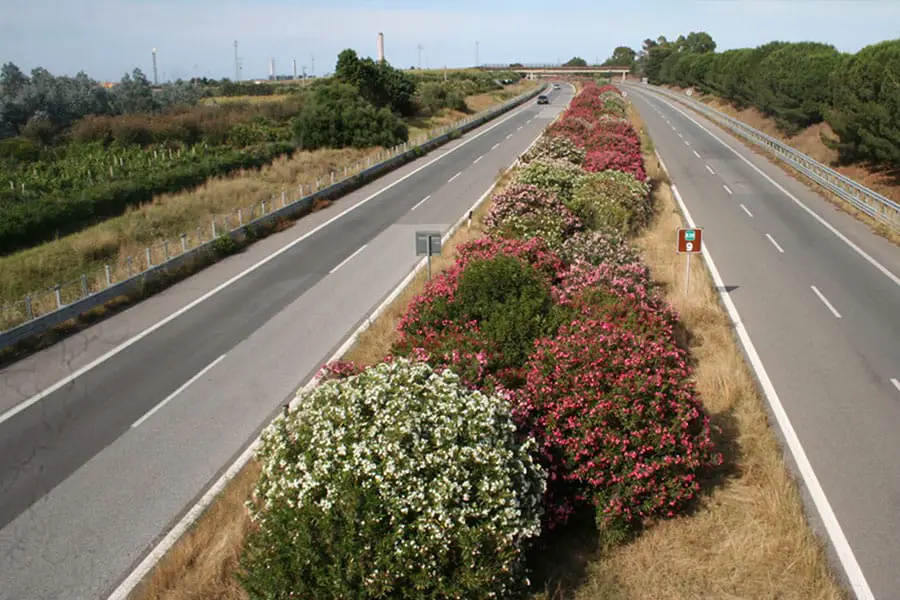
There very popular and a good choice for being used as privacy screens in garden designs because of there fast growth and vast amount of flower buds they produce. This Ornamental Shrub can have Pink Flowers, Yellow Flowers, White Flowers, Red Flowers and even Orange Flowers depending on which variety you get.
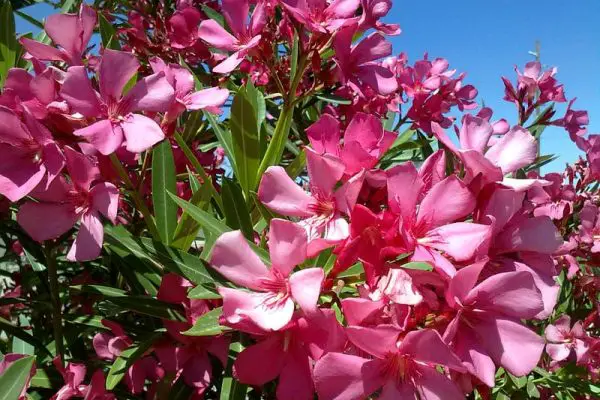
- Nerium oleander – Oleander Plant Overview
- How to Grow and Care for Your Nerium Oleander
- Ideal Soil for Oleander
- How much light does Oleander need?
- How much water does a Oleander plant need?
- Fertilising Your Plant
- Overwintering Oleanders Grown in Containers
- How to Prune an Oleander plant
- How to propagate an Oleander plant
- Propagation Videos
- Oleander Toxicity
- Pests
Nerium oleander – Oleander Plant Overview
- Common Name: Oleander
- Scientific Name: Nerium oleander
- Family: Apocynaceae
- Origin: North Africa, Mediterranean, Southern Asia
- Flower Colour: Various Colours and shades; Pink, White, Yellow, Orange, Red
- Ultimate Height: Up to 3m / 9 ft
- Ultimate Spread: 1 – 1.5 metres / 3 – 5 ft
- Time To Ultimate Height: 10-20 years
- Leaf: Evergreen
- Plant Hardiness: UK = H3 / USA 8
- Temperature: Foliage damage below -9°C / 15°F and dieback from below -12°C / 10°F).
- Light: Full Sun
- Water: Low
- Soil: Tolerant of all Soil types and tolerant to salt spray
- Fertiliser: Fertiliser Not needed
- Propagation: Stem cuttings or seed
- Pests: Aphids, Mealybugs, Spider Mites. Has a natural predators Oleander Caterpillar and Oleander Hawk-moth. Usually disease free.
- Poisonous for pets: Toxic to ALL animals
How to Grow and Care for Your Nerium Oleander
The Oleander plant is an evergreen shrub that can grow into a oleander tree, if you give it time and it’s correctly pruned, with almost leathery green leaves, which produce an abundance of clusters of flowers. Plants can have Pink, Red, White, Orange, Yellow, Orange or even a combination of different colours that have been grafted on. There are over400 cultivars of Oleander to choose from.
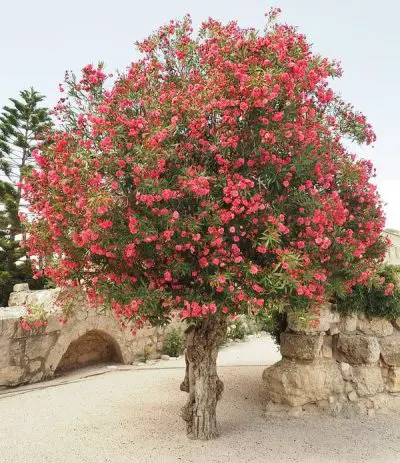
This oleander plant has has 3 different oleander colours on it. Two of which have been grafted onto it.
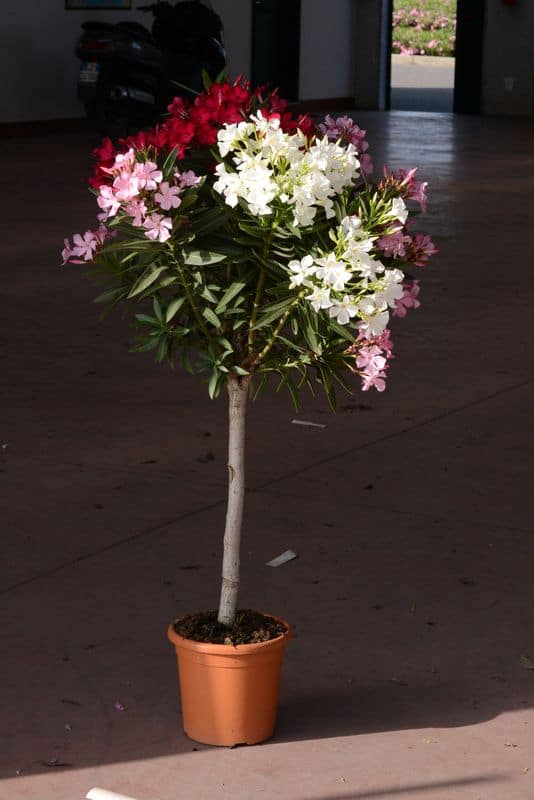
They can be grown outdoors in the ground all year round in the South East of England, or in city gardens such as London, which are usually warmer and provide shelter from severe frost. However, they can also be grown in containers and brought indoors over winter if winter temperatures in your location get too cold.
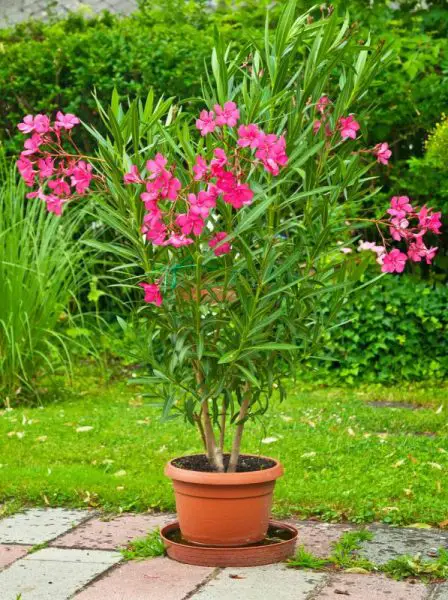
Ideal Soil for Oleander
Oleander plants will grow in almost anything, but it helps to get them off to the best start by giving them the ideal soil medium to encourage a healthy root system.
In their native habitats (the Mediterranean, the Middle East, India, and subtropical Asia) oleanders typically grow in sandy soil where there is abundant groundwater or where there are periods of flooding and then draining.
If growing them in containers you should aim for a well-draining soil mix, 4-parts potting soil, 1-part sand, and 1-part perlite.
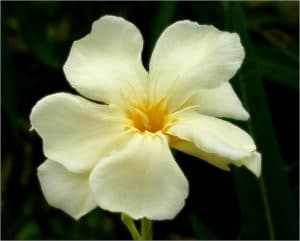
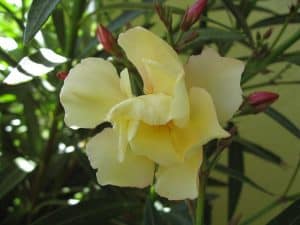
How much light does Oleander need?
Well there’s a saying “bake them in the sun”, Oleander prefers full sun but will tolerate part shade. If your growing them in containers, remember when setting plants outside in the spring for the first time, to acclimatise them. Give them only about 45 minutes to an hour of direct sunlight the first day; add a half hour each day. After about a week, they’ll be ready and willing to take full sun all day.
How much water does a Oleander plant need?
Established plantings of Oleander is considered tolerant of ordinary drought conditions. They will survive receiving little or no supplemented watering aside from natural rainfall. However, drought stress has adverse effects, such as reducing growth rate and flower production. Supplemental watering at the rate of 1-2 inches / 2.5 – 5cm per week, during dry weather, promotes continuous flowering and constant growth of plants.
Yellowing leaves usually means that you are over-watering your Oleander.
With Oleander in pots give them a generous amount of water when it’s hot (especially while they’re flowering), but when temperatures cool down at night, it is a very good idea to play it safe and let the mix get somewhat dry between watering.
Fertilising Your Plant
Newly established plantings of oleander rarely require fertilisation, your Oleander plant will be just as happy with no added fertiliser.
Plants may respond favourably when fertilised by increasing growth rate and flower production. Signs of unfavourable soil nutrient levels for oleander include light green, often small leaves, short internodes, lack of terminal growth of stems and sparse flowering.
If you wish to maximise plant growth and flowering, then I would suggest giving them a high nitrogen fertiliser until June every 2 weeks from early spring. Then switch to a high potassium fertiliser until mid-August, this will promote blossoms and discourage the production of tender new growth.
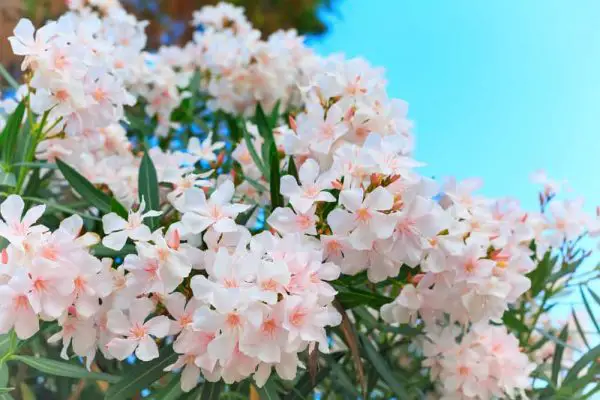
Overwintering Oleanders Grown in Containers
There will come a point when your Oleander plants need a rest from their long season of blooming. As long as the temperature is kept above freezing, the plants will be fine.
However, to avoid loss from root- or stem-rot, it is important to reduce watering to a minimum. The cooler the temperature, the less water and light the plants will need; keep them on the dry side. An unheated, bright porch or sun room is ideal, provided the temperature remains above freezing. Oleanders can also be overwintered at normal room temperatures. The warmer they are, however, the more light and water they will need. When you notice new, shiny, light green shoots emerging from the tips of the branches in the spring, it’s time to give them warmth, sun, increased water and fertiliser.
How to Prune an Oleander plant
Pruning will reward you with a strong, healthy plant with lots of bloom. Here is how the procedure goes: Oleander should be cut back just above the leaf nodes. This is the section where three leaves will come out of the branch.
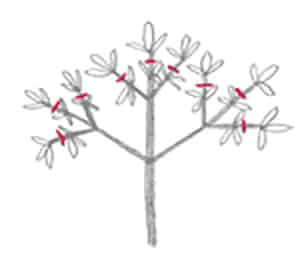
By cutting it here, you will force new branching at each of the leaf nodes (joints). You will therefore get three new branches coming from the section which once had three leaves. By letting these new branches grow a little and then pruning them (at the leaf nodes), you will again force new branching to occur at these points.
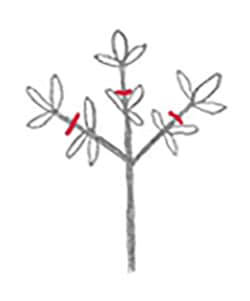
By doing this, you will again increase the branch threefold. This is how you get round, bushy plants. Remember, the location of your first pruning should be low on the plant to allow a good base structure for all the future branching. See sketch. At each new branch tip you should get a flower cluster forming. Therefore, by having more branches, you will also get more flowers.
Why Prune?
The main reason people prune an oleander is to shape them and force more branching – giving more flower clusters.
When should I prune?
The best time to prune oleander is around September into early October. Pruning any later will cut off the Spring growth.
Does Oleander bloom on old wood or new wood?
Flower clusters appear at the tips of new wood.
How much can I trim my plants?
Oleanders are strong and can take a good amount of pruning in case you get carried away. Don’t be afraid to cut them back to whatever base height you may want – especially if you feel they’ve lost control!
How to propagate an Oleander plant
It is very easy to propagate from oleander cuttings.
Propagation of Oleander can be done in 2 ways:
One says use the hardwood, while the other says that tip cuttings are the best. You can use either way and still be successful.
Make your cuttings about 6 inches long each and remove the lower leaves. The location of the bottom three leaf nodes is where your roots will start, although they will progress elsewhere. Cut the remaining upper leaves to about one inch long.
You can place these in water by themselves, or you can add a small twig of willow (which acts as a stimulator) along with the cuttings in the water. After the roots grow to between one and two inches long, transplant into some good draining soil. Keep it moist, but not wet, and in a mostly sunny location.
OR
Dip the bottom end of your cutting in some root hormone and plant it in some well-draining soil. If you don’t have rooting hormone, you can use cinnamon.
Either method should bring results in about two weeks. In about a year, these will have grown in size. Don’t forget to prune them now so you get the shape and structure you want.
Remember that Oleander blossoms on last year’s growth, this year’s growth will blossom next year.
I have had the most success with the hardwood dipped in cinnamon method.
Propagation Videos
Oleander Toxicity
All parts of Oleander are poisonous and extremely toxic it’s one of the most poisonous plants out there. With the correct handling and educating young children, you should have nothing to worry about. I’ve seen them growing around school yards in Portugal. As long as you’re not planning to eat them, you’ll be fine.
Oleander contains a toxin called Cardenolide Glycosides, which effects the heart muscles causing heart failure. The toxin is mostly contained in the sap, which is clear to slightly milky coloured and sticky. When ingested in certain quantities, this toxin can cause harm – and possibly death. The extremely bitter and nauseating taste of the sap (much like a rotten lemon) causes a mechanical reflex in the stomach which rejects and expels the vile substance. Although not impossible, a person or animal would have to have a strong stomach or no sense of taste for a dose of the toxin contained to be fatal.
What can I do to avoid the possibility of poisoning when working with Oleander? Wash hands (and arms) thoroughly when finished working with the plant.
Do not chew on any part of this plant, consumption of ONE leaf is enough to kill a young child.
Do not burn N. Oleander in a your garden or even in a garden incinerator, the fumes from a burning Oleander is still very hazardous. Steer clear of the fumes and NEVER use the branches as firewood or use it as a skewer for food (or as a toothpick!).
Just for the record Peace Lily and Daffodils are two other toxic plants that are just as toxic as your Oleander shrub.
Pests
Oleander has 2 natural predators that will feed on its leaves immune to its toxicity.
They are:
1 – Oleander caterpillar
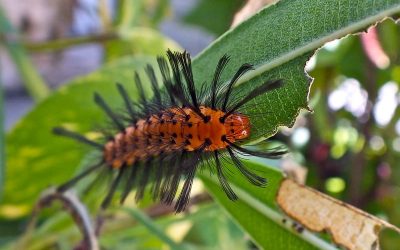
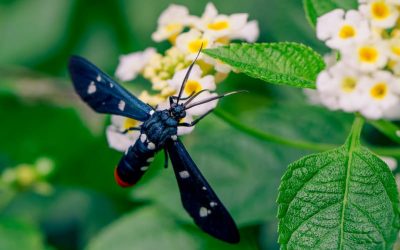
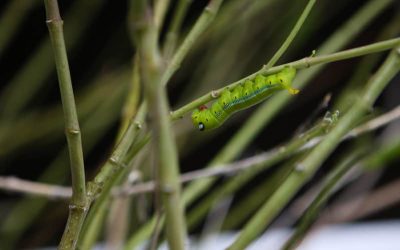
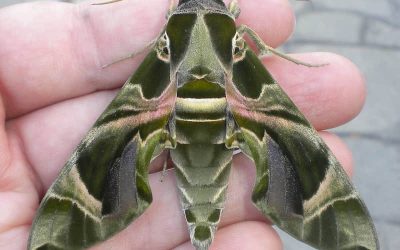
Other than these 2 mentioned above you also have aphids and scale insects.
Scale insects are the worst pest indoors but in my experience they only attack plants which are already weakened by stress, especially due to water loss or mechanical injury indoors they can also fall prey to red spider mite, Oleander aphids and mealybugs.
